Abstract
In this article, the authors study the comparison of the generalization differential transform method (DTM) and fuzzy variational iteration method (VIM) applied to determining the approximate analytic solutions of fuzzy fractional KdV, K(2,2) and mKdV equations. Furthermore, we establish the approximation solution two-and three-dimensional fuzzy time-fractional telegraphic equations via the fuzzy reduced differential transform method (RDTM). Finding an exact or closed-approximation solution to a differential equation is possible via fuzzy RDTM. Finally, we present the fuzzy fractional variational homotopy perturbation iteration method (VHPIM) with a modified Riemann-Liouville derivative to solve the fuzzy fractional diffusion equation (FDE). Using this approach achieves a rapidly convergent sequence that approaches the exact solution of the equation. The proposed methods are investigated based on fuzzy fractional derivatives with some illustrative examples. The results reveal that the schemes are highly effective for obtaining the solutions to fuzzy fractional partial differential equations.
1. Introduction
The fuzzy fractional differential equations (FFDEs) are frequently employed as models in a variety of research fields, including the civil engineering, evaluation of weapon systems, population modeling, and electro-hydraulics modeling. Consequently, FFDEs have gained a lot of attention in the areas of mathematics and engineering. In particular, Agarwal et al. [] originally developed FFDEs, ignoring the importance of fuzzy derivatives. In other words, they introduced a new class of FFDEs by incorporating fuzzy uncertainty into dynamic systems. Nonetheless, the growth of FFDEs has been significantly linked to the emergence of various forms of fuzzy derivatives. Allahviranloo et al. [] proposed FFDEs under Riemann-Liouville Hukuhara differentiability, which is a straightforward extension of the fractional Riemann-Liouville derivative utilizing the Hukuhara difference. The authors of [] presented the FFDEs based on the fuzzy fractional derivative of the Caputo type. Moreover, fuzzy derivatives based on the Hukuhara difference encounter some problems when the diameter of uncertainty increases with time. Therefore, generalizations of the Hukuhara derivative are acknowledged as an active research direction and constitute a substantial development. Considering the extensions of Bede and Gal [] on the differentiability of fuzzy-valued functions, the references [,,] introduced the generalized Hukuhara derivatives of interval-valued functions and fuzzy-valued functions. In [,], the generalized Caputo fractional derivative and the Riemann–Liouville fractional derivative were introduced together with their many applications.
Zhou [] proposed the concept of DTM to solve the initial value problem of linearity–nonlinearity in polynomial form for circuit analysis, unlike traditional higher-order Taylor series that involve the symbolic computation of data functions derivatives. Later, this method was considered by many authors; see [,,].
To overcome the lack of complex conversion of DTM, a reduced differential transform method (RDTM) was introduced by Keskin et al. [,], which is a reliable semi-analytical method used to find the approximate solutions of the partial differential equations (PDEs), and there have been few essential applications of RDTM [,,]. In particular, [] has shown that recursive RDTM equations produce all Poisson series coefficients for solutions altogether. However, recursive DTM equations entirely produce all Taylor solution coefficients, which is an advantage of the RDTM. Recently, the authors have used this method for solving some problems in the fuzzy environment; see [,,].
He [] created the HPM, which he applied to nonlinear problems by employing homotopy theory from topology []. The HPM has been the subject of numerous discussions by different authors. Particularly, the authors of [] discussed the comparison of fuzzy HPM as well as other approaches to solving the fuzzy -dimensional Burgers’ equation. Doan et al. [] presented the new technique to efficiently approximate both linear buckling loads and associated mode shapes of finite element structures subject to perturbations. Noeiaghdam et al. [] studied the dynamical strategy of HPM for solving second-kind integral equations using the CESTAC method. Osman et al. [] compared HPM with different methods to solve fuzzy wave-like and heat-like equations.
In 1998, He first introduced the variational iteration method (VIM) []. Later, many researchers confirmed that VIM is a valuable method for solving some problems; see [,,]. Moreover, various authors investigated the VIM in a fuzzy environment. In [], the authors solved nonlinear fuzzy differential equations via the fuzzy VIM. Osman et al. [] presented the comparison of VIM with another technique to obtain the solution of fuzzy wave-like and heat-like equations. Mungkasi [] investigated the variational iteration with successive approximation techniques for an SIR epidemic model and constant vaccination strategy. Mustafa et al. [] studied the fuzzy variational problem with fuzzy optimal control problem under granular differentiability. Chu et al. [] proposed the fractional third-order dispersive PDEs utilizing Shehu decomposition and VIM. Hijaz et al. [] studied a new method called the fractional iteration algorithm-I for solving nonlinear, noninteger-order partial differential equations numerically.
In the present paper, the authors compare the generalization of DTM with fuzzy VIM applied to obtain the solutions of fuzzy fractional KdV, K(2,2), and mKdV equations. The primary advantage of the VIM is its rapid solution convergence. The acquired numerical results confirm its extremely high level of precision. Moreover, we establish the approximation solution two-and three-dimensional fuzzy time-fractional telegraphic equations via the fuzzy RDTM. The technique is directly used without linearization, discretization, transformation, or restrictive assumptions. It is not difficult to apply this method to the multidimensional time-fractional order physical problems that crop up in a variety of engineering and scientific fields. Finally, we propose a fuzzy fractional VHPIM to obtain the solution to the fuzzy fractional diffusion equation. The numerical results demonstrated that the scheme is an effective and accurate technique for solving fuzzy time-fractional diffusion equations.
The present article has six sections. In Section 2, we will review several important definitions. In Section 3, we studied the comparison of the DTM and fuzzy VIM applied to determining the approximate analytic solutions of fuzzy fractional KdV, K(2,2), and mKdV equations. In Section 4, we investigate the approximation solution of fuzzy time-fractional telegraphic equations via fuzzy RDTM. Section 5 considers the fuzzy fractional VHPIM applied to solve the fuzzy fractional diffusion equation. The final part of the article, Section 6, presents the conclusions.
2. Preliminaries
Let us assume that is the set of fuzzy subsets of the real axis, if and the following conditions hold:
- i.
- is upper semi-continuous on R;
- ii.
- is fuzzy convex;
- iii.
- is normal;
- iv.
- Closure of is compact.Then stands for the space of fuzzy numbers. For denote and Then, from the above conditions, it follows that the -level set is the closed interval for any . For arbitrary and , the addition and scalar multiplication are given by
- (1)
- (2)
For , we denote the Hausdorff distance between fuzzy numbers by The metric space is complete, separable, and the following three conditions of the metric d are valid (see []):
- (1)
- (2)
- (3)
The fuzzy-valued function is represented at the -level as , . Say that the fuzzy-valued function is integrable on , if the function is continuous in the metric d, its definite integral exists. Moreover, we obtain
Definition 1 ([]).
Let us assume that are fuzzy numbers. Then, the gH-difference between is defined as follows:
When it comes to the ϱ-level, we arrive at , as well as if the H-difference exists, then ; the conditions for the existence of are
It is not difficult to show that the above two cases hold if and only if is a crisp number. The gH-difference between fuzzy numbers probably does not exist. To fix this, fuzzy numbers are differentiated [].
Definition 2 ([]).
A fuzzy-valued function of two variables is a rule that assigns to each ordered pair of real numbers, , in a set D, denoted by , the unique fuzzy number. The domain of denotes D, and its range is the set of values that can take, so .
Let us consider is the parametric representation of the fuzzy-valued function. Then, for all and , the following inequality holds:
Definition 3 ([]).
Let be a fuzzy-valued function of two variables. Then, we say that the fuzzy limit of as approaches is , and we write if for every number , there is a corresponding number such that if , where denotes the Euclidean norm in .
Fuzzy Fractional Calculus
The symbols and stand for the space of any fuzzy-valued functions which are continuous on the interval and the space of any Lebesgue integrable fuzzy-valued functions on the bounded interval , respectively.
Definition 4 (cf. []).
Let us assume that . The definition of the fuzzy Riemann–Liouville integral of fuzzy-valued function is as follows:
Let us assume the ϱ-level formula of a fuzzy-valued function, , is written as for ; we may utilize the lower and upper functions to express the fuzzy Riemann–Liouville integral of in terms of the lower and upper functions as follows.
Theorem 1 ([]).
Let us assume that . Then, the fuzzy Riemann–Liouville integral of fuzzy-valued function is defined as:
where and
Definition 5.
Let us assume . Then, the Mittag–Leffler function is represented as follows:
Definition 6 ([,]).
Let us assume that is a fuzzy-valued function and that . Then, is said to be Caputo’s gH-differentiable at Λ when
Notice that later, we indicate using the expression
Theorem 2 ([]).
Assume that and . Then,
- (i)
- Let be an (i)-differentiable fuzzy-valued function. Then, we have
- (ii)
- Let be a (ii)-differentiable fuzzy-valued function. Then, we have
3. Fuzzy Fractional Partial Differential Equations
In this section, we present the fuzzy fractional KdV, K(2,2), and mKdV equations using the generalized two-dimensional differential transform method with the fuzzy variational iteration method.
3.1. Generalized Two-Dimensional Differential Transform Method
Consider the real-valued function with two variables denoted by , and assume that it can be written as the product of two real-valued functions with a single parameter each, as shown by the equation . The function can be calculated using the properties of generalized two-dimensional DTM as follows:
where , denote the spectrum of . In the domain of interest, if the real-valued function is analytic and continuously differentiated with respect to time t, then we define the generalized two-dimensional DTM of the function as follows:
where
The lowercase denote the original real-valued function while the uppercase denote the transformed function. The generalized inverse DTM of is:
In case of and , the generalized two-dimensional DTM (5) reduces to the classical two-dimensional DTM []. Applying (5) and (6), some basic properties of the generalized two-dimensional DTM form are proposed.
Theorem 3.
If
Theorem 4.
If , then
Theorem 5.
If then
Theorem 6.
If then
Theorem 7.
If and , then we obtain
3.2. Fuzzy Variational Iteration Method
The following is considered a fuzzy fractional differential equation:
where
, denotes the nonlinear operator, denotes the linear operator, is a known analytic fuzzy-valued function and is the fuzzy Caputo’s fractional derivative of order ℑ.
The initial conditions (9) are given in terms of the field variables and their integer order as follows:
where denote the fuzzy-valued functions. The solution of
Equation (9) can be derived from the iteration formula,
and
where denotes the fuzzy Riemann–Liouville fractional integral operator of order , and denotes the fuzzy Caputo fractional derivative, of order Applying the alternative approach of fuzzy VIM as follows
Using the iteration formula
and
3.3. Applications
In this part, we apply the methods to obtain the solution of fuzzy partial differential equations.
Example 1.
We consider the following fuzzy fractional KdV equation
under the initial condition
Case 1. The differential transform method
The solution for is
We can obtain the solution for as:
Case 2. Fuzzy variational iteration method
Taking the mentioned iteration formula, we obtain
and
For we obtain the approximate solution as follows:
after some steps, the exact solution is obtained as follows:
Then, we obtain
Meanwhile, the DTM and fuzzy VIM lower and upper solution of Equation (16) are demonstrated in Figure 1a, where and show the precision and compliance with the proposed theory.

Example 2.
We consider the following fuzzy fractional equation
under the initial condition
Case 1. The differential transform method
Taking the initial condition (33), we obtain
and
Using (37) into (34), we can obtain some value of as
and
The solution for is
For we obtained the exact solutions as
Case 2. Fuzzy variational iteration method
Taking the mentioned iteration formula, we obtain
and
For we obtain the approximate solution as follows:
The exact solution is obtained as:
We obtain
The DTM and fuzzy VIM lower and upper solution of Equation (32) are demonstrated in Figure 1b, where and show the precision and compliance with the proposed theory.
Example 3.
We consider the following fuzzy modified fractional KdV (mKdV) equation
under the initial condition
Case 1. The differential transform method.
Using the two-dimensional DTM to (50), we obtain
Using the initial condition (51), we can obtain
and
Case 2. Fuzzy variational iteration method
Using the fuzzy iteration formula for problem (50), we deduce that
and
Using the mentioned iteration formula, we infer that
and
For we can obtain the exact solution as:
4. Fuzzy Time-Fractional Telegraphic Equations
In the current section, we establish the fuzzy time-fractional telegraphic equations via the fuzzy reduced differential transform method. Let and denote the electric voltage and the current in a double conductor.
- Consider the two-dimensional fuzzy fractional telegraphic equations of the formwhere andSubject to the initial conditions
- Consider the three-dimensional fuzzy fractional telegraphic equations of the formwhere andSubject to the initial conditionswhere p and q denote constants.
4.1. Fuzzy Reduced Differential Transform Method
In this part, we give some basic definitions of fuzzy RDTM. Consider a fuzzy-valued function of some variables ; where , we can obtain
where is called the spectrum function of . Let and denote the RDTM operator and inverse RDTM operator, respectively.
Definition 7.
If the fuzzy-valued function is analytic and continuously differentiable with respect to space variables and time variable t in the domain of interest, then the spectrum function
Definition 8.
Let us assume is the fuzzy valued function and that is the real valued function. Then, , and the convolution ⊗ denotes the reduced differential transform version of multiplication; then, the basic operations of the RDTM are expressed as follows:
- 1.
- 2.
- 3.
- 4.
- 5.
- 6.
- 7.
- 8.
4.2. Two-Dimensional Fuzzy Time-Fractional Telegraphic Equations
We consider the following two-dimensional fuzzy time-fractional telegraphic Equation (62) as
and
where
4.3. Three-Dimensional Fuzzy Time-Fractional Telegraphic Equations
Consider the following three-dimensional fuzzy time-fractional telegraphic Equation (64) as:
and
From the initial conditions (65), it follows that
and
The approximate solution for and = is as follows
and
4.4. Applications and Results
In this part, we present the approximate solution of fuzzy time-fractional telegraphic equations via fuzzy RDTM.
Example 4.
We consider the following two-dimensional fuzzy linear time-fractional telegraphic equation
under the initial conditions
Utilizing the differential inverse fuzzy RDTM on , we obtain
and
Thus, when i.e., , it is easy to arrive at the exact solution:
The fuzzy RDTM lower and upper solution of Equation (90) are demonstrated in Figure 2a, where and show the precision and compliance with the proposed theory.

Example 5.
Let us turn to consider the following three-dimensional fuzzy linear time-fractional telegraphic equation
under the initial conditions
Utilizing the fuzzy differential inverse RDTM on , we obtain
and
Thus, when i.e., , it is easy to arrive at the exact solution:
The fuzzy RDTM lower and upper solution of Equation (100) are demonstrated in Figure 2b, where and show the precision and compliance with the proposed theory.
Example 6.
Let us now consider the following two-dimensional nonlinear fuzzy time-fractional telegraphic equation
under the initial conditions
Similarly, using the differential inverse RDTM on , when it is easy to arrive at the exact solution:
The fuzzy RDTM lower and upper solution of Equation (110) are demonstrated in Figure 2c, where and show the precision and compliance with the proposed theory.
Example 7.
Let us next consider the following three-dimensional nonlinear fuzzy time-fractional telegraphic equation
under the initial conditions
Similarly, using the differential inverse RDTM on , when , it is easy to arrive at the exact solution:
5. Fuzzy Time-Fractional Diffusion Equation
In the current section, let us present the definition of the fuzzy fractional VHPIM, which is utilized to solve the fuzzy fractional diffusion equation.
Assume that is called the continuous function. Through the fractional Riemann–Liouville integral
the modified Riemann–Liouville derivative is given by
The formula for Jumarie’s fractional derivative of order ℑ is as follows:
where
for
The presented modified Riemann–Liouville derivative as given in (127) is strictly equivalent to (128), cf. [,]. The integral with respect to is given by
Suppose that is a continuous function, then the solution of (130) is given by
Before recalling the fuzzy time-fractional diffusion equation, we introduced a few notations which will be utilized throughout this part. For order ℑ, we denote by the modified Riemann–Liouville derivative. The symbols ∇ and Δ denote the Hamilton and the Laplace operators, respectively. The expression stands for the spatial domain of the problem, d is the dimension of the space, , denotes the boundary of , indicates the probability density fuzzy-valued function of locating a particle at in time t. The letter D stands for the positive constant depending on the temperature, the friction coefficient, the universal gas constant, and the Avagadro constant. Moreover, is the external force.
Let us recall the fuzzy time-fractional diffusion equation given by the formula:
under the initial condition
as well as boundary condition
From (132), it can be viewed as modeling the diffusion of a particle under the action of the external force
5.1. Analysis of the Method
Here are the main steps of the fuzzy fractional variational homotopy perturbation iteration method:
Step 1. Let us say that a nonlinear equation, with two independent variables and t, as follows:
where stands for the fuzzy Riemann–Liouville derivative, , the symbols and stand for nonlinear and linear operators, respectively. We denote by the fuzzy inhomogeneous term, and is an unknown fuzzy-valued function.
Step 2. Let us construct the correct functional as follows:
whenever the letter appears, it refers to a general Lagrange multiplier that variational theory can ideally describe. The symbol means the approximation, and the fuzzy-valued function is a restricted variant that corresponds to the formula
Step 3. Based on the fuzzy fractional VHPIM, let us derive the following iteration formula
and
where stands for an imbedding parameter, and is the initial approximation of (135).
5.2. Application of the Method
In this part, let us consider the correctness of the following functional for Equation (132), which we define as follows:
and
where the expression denotes the restricted variation, which means , and is an initial approximation that must be chosen as suitable. The following can be utilized to find the fixed conditions:
Hence, the Lagrange multiplier can be determined as . Utilizing Equations (139) and (140), we can formulate the iteration as follows:
and
where is the initial approximate of Equation (132). In comparison to the coefficient of the same power of q in both hands of the above Equations (141) and (142), it is easy to obtain , with
Using the fuzzy homotopy perturbation method, we obtain
5.3. Examples
We propose the different examples to illustrate the fuzzy fractional diffusion equation via fuzzy fractional VHPIM.
Now, let us discuss the fuzzy fractional diffusion equation in one dimension as the following:
Example 8.
Let us set and then, Equation (132) can be written as
under the initial condition
and the boundary conditions
Therefore, the limit has a compact form, as demonstrated below:
and
The solution can be expressed in mathematical form as shown below:
In the work of Osman et al. [], the authors mentioned that for their method, the solution is convergent for , but the issue of convergence of the fuzzy fractional VHPIM for large t is, in general, rather delicate. Therefore, we give the comparison for the VHPIM with Example in [] and obtained that the solution for Example 8 using fuzzy fractional VHPIM in our current work shows convergence until time . Hence, this shows that our method gives better results in comparison. Meanwhile, we have also compared the error terms between exact and approximate solutions in Example 8 for between 0 and 1 in Table 1 for giving the clear solution for the fuzzy fractional diffusion equation. Moreover, to present the solution in more depth, we plotted the solution in 3D as well, which can be seen in Figure 3b and Figure 4b.

Table 1.
Table for the error term between exact solutions (ES) and approximate solutions (AS).
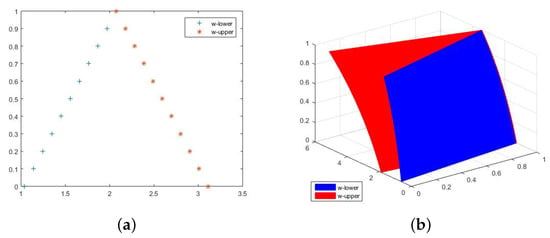
Figure 3.
The approximate lower and upper solutions of Equation (144) at . (a) 2D figure for the approximate solutions of one-dimensional fuzzy fractional diffusion equation of w in Example 8. (b) 3D figure for the approximate solutions of w in Example 8.
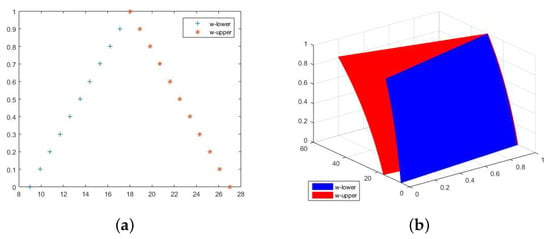
Figure 4.
The exact lower and upper solutions of Equation (144) at . (a) 2D figure for exact solutions of one-dimensional fuzzy fractional diffusion equation of w in Example 8. (b) 3D figure for the exact solutions of w in Example 8.
In Figure 3, we plotted and graphs of the approximation solution for fuzzy FDE. Figure 3a shows that for using at , the fuzzy FDE become bounded and closed. Moreover, the represents increasing functions and denotes the decreasing functions on the -level set of w. To discuss the concept of the -level set, it can be noted in Figure 3b that the -level set of the approximate solution for fuzzy FDE is bounded and closed for , and . Similarly, in Figure 4, we can observe the same explanation of —level set closedness and boundedness for Example 8.
In the next example, we consider a fuzzy fractional diffusion equation in two dimensions.
Example 9.
Let us assume , and Then, Equation (132)
under the initial condition
as well as the boundary conditions
Hence, the solution can be easily deduced as follows:
In the work of Osman et al. [], the authors mentioned that for their method, the solution is convergent for , but the issue of convergence of the fuzzy fractional VHPIM for large t is, in general, rather delicate. Therefore, we give the comparison for the VHPIM with Example in [] and obtained the solution for Example 9 using fuzzy fractional VHPIM in our current work, which shows convergence until time . Hence, this shows that our method gives better results in comparison. Meanwhile, we have also compared the error terms between exact and approximate solutions, which are fractional values of ℑ, in Example 9 for between 0 and 1 in Table 2 for giving the clear solution for the 2D fuzzy fractional diffusion equation. Moreover, to present the solution in more depth, we plotted the solution in 3D as well, which can be seen in Figure 5b and Figure 6b.

Table 2.
Table for the error term between exact solutions (ES) and approximate solutions (AS).
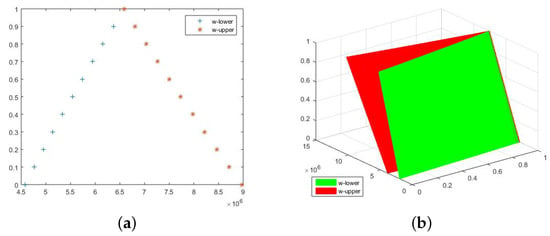
Figure 5.
The exact lower and upper solutions of Equation (151) at . (a) 2D figure for the exact solutions of two-dimensional fuzzy fractional diffusion equation of w in Example 9. (b) 3D figure for the exact solutions of w in Example 9.
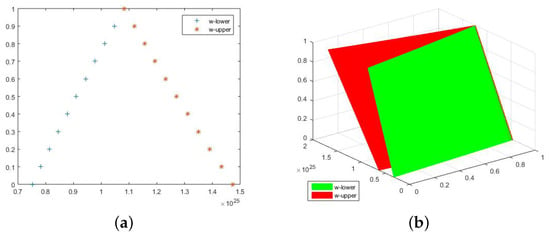
Figure 6.
The approximate lower and upper solutions of Equation (151) at . (a) 2D figure for the approximate solutions of two-dimensional fuzzy fractional diffusion equation of w in Example 9. (b) 3D figure for the approximate solutions of w in Example 9.
In Figure 5, we plotted and graphs of the exact solution for fuzzy FDE. Figure 5a shows that for using at , the fuzzy FDE become bounded and closed. Moreover, the shows increasing functions and denotes the decreasing functions on the -level set of w. To discuss the concept of the -level set, Figure 5b illustrates that the -level set of fuzzy FDE is bounded and closed for , and . Similarly, in Figure 6, we can observe the same explanation of -level set closedness and boundedness for Example 9.
In the next example, let us consider then, Equation (132) has the following:
Example 10.
Take into consideration the three-dimensional fuzzy fractional diffusion equation
under the initial conditions
as well as the boundary conditions
Hence, we obtain a compact form
Thus, the following is the solution
In the work of Osman et al. [], the authors mentioned that for their method, the solution is convergent for , but the issue of convergence of the fuzzy fractional VHPIM for large t is, in general, rather delicate. Therefore, we give the comparison for the VHPIM with Example in [] and obtained that the solution for Example 10 using fuzzy fractional VHPIM in our current work shows convergence until time . Hence, this shows that our method gives better results in comparison. Meanwhile, we have also compared the error terms between exact and approximate solutions for Example 10 for between 0 and 1 in Table 3 for giving the clear solution for the 2D fuzzy fractional diffusion equation. Moreover, to present the solution in more depth, we plotted the solution in as well, which can be seen in Figure 7b and Figure 8b.

Table 3.
Table for the error term between exact solutions (ES) and approximate solutions (AS).
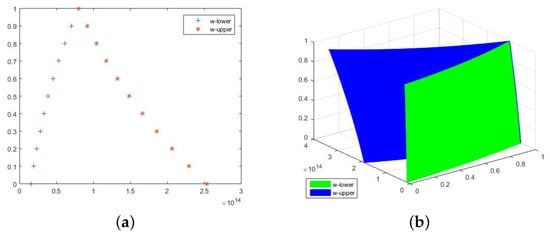
Figure 7.
The exact lower and upper solutions of Equation (156) at . (a) 2D figure for the exact solutions of three-dimensional fuzzy fractional diffusion equation of w in Example 10. (b) 3D figure for the exact solutions of w in Example 10.
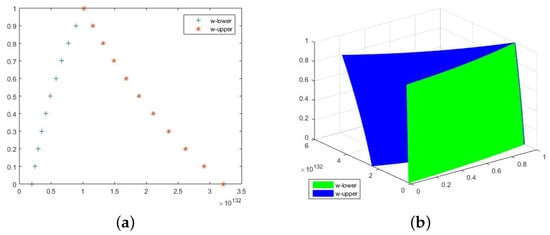
Figure 8.
The approximate lower and upper solutions of Equation (156) at . (a) 2D figure for the approximate solutions of three-dimensional fuzzy fractional diffusion equation of w in Example 10. (b) 3D figure for the approximate solutions of w in Example 10.
In Figure 7, we plotted and graphs of the exact solution for fuzzy FDE. Figure 7a shows that for using at , the fuzzy FDE become bounded and closed. Moreover, the sign shows increasing functions and denotes the decreasing functions on the -level set of w. To discuss the concept of the -level set, Figure 7b illustrates that the -level set of fuzzy FDE is bounded and closed for , and . Similarly, in Figure 8, we can observe the same explanation of -level set closedness and boundedness for Example 10.
6. Conclusions
This research introduced the comparative study of generalization DTM and fuzzy VIM for successful application to determine the approximate analytic solution of fuzzy fractional KdV, K(2,2), and mKdV equations. The primary advantage of the VIM is its rapid solution convergence. These numerical results conform its high level of precision. In addition, two-dimensional and three-dimensional approximation fuzzy time fractional telegraphic equations were established through the fuzzy RDTM instead using transformation, discretization, linearization, or restrictive assumption. Furthermore, the fuzzy VHPIM was presented and applied to solve the fuzzy fractional diffusion equation. The numerical analysis demonstrated that the fuzzy fractional VHPIM is an efficient technique for solving time-fractional diffusion problems by employing the initial conditions. Moreover, the boundary conditions can be used to justify the proposed solution that has been determined. The methods are investigated based on fuzzy fractional derivatives. Several examples put the proposed methods to the test. The solutions obtained by these four methods are illustrated in Figure 1, Figure 2, Figure 3, Figure 4, Figure 5, Figure 6, Figure 7 and Figure 8, showing the effectiveness and compliance with demonstrated theory and the potential to rely on these techniques without an exact solution. The analysis displayed that the proposed methods effectively obtain a solution for the fuzzy fractional partial differential equations.
Author Contributions
Conceptualization, M.O.; Validation, M.O. and S.A.A.; writing original draft, M.O.; Writing-review and editing M.O. and O.A.O.; Funding acquisition M.O, Formal analysis, M.O. and S.A.A.; Investigation, A.A. and A.M.M.; Methodology, M.O. and O.A.O. All authors have read and agreed to the published version of the manuscript.
Funding
The research was supported by Zhejiang Normal University Research Fund under Grant ZC304022909.
Institutional Review Board Statement
Not applicable.
Informed Consent Statement
Not applicable.
Data Availability Statement
Not applicable.
Acknowledgments
The authors are grateful to the editor and anonymous reviewers for their helpful, valuable comments and suggestions in the improvement of this manuscript.
Conflicts of Interest
The authors declare no conflict of interest.
References
- Agarwal, R.P.; Lakshmikanthama, V.; Nieto, J.J. On the concept of solution for fractional differential equations with uncertainty. Nonlinear Anal. Theory Meth. Appl. 2009, 72, 2859–2862. [Google Scholar] [CrossRef]
- Allahviranloo, T.; Salahshour, S.; Abbasbandy, S. Explicit solutions of fractional differential equations with uncertainty. Soft Comput. 2012, 16, 297–302. [Google Scholar] [CrossRef]
- Mazandarani, M.; Kamyad, A.V. Modified fractional Euler method for solving fuzzy fractional initial value problem. Commun. Nonlinear Sci. Numer. Simul. 2013, 18, 12–21. [Google Scholar] [CrossRef]
- Bede, B.; Gal, S.G. Generalizations of the differentiability of fuzzy number valued functions with applications to fuzzy differential equations. Fuzzy Sets Syst. 2005, 151, 581–599. [Google Scholar] [CrossRef]
- Stefanini, L.; Bede, B. Generalized Hukuhara differentiability of interval-valued functions and interval differential equations. Nonlinear Anal. 2009, 71, 1311–1328. [Google Scholar] [CrossRef]
- Stefanini, L. A generalization of Hukuhara difference and division for interval and fuzzy arithmetic. Fuzzy Sets Syst. 2010, 161, 1564–1584. [Google Scholar] [CrossRef]
- Bede, B.; Stefanini, L. Generalized differentiability of fuzzy-valued functions. Fuzzy Setes Syst. 2013, 230, 119–141. [Google Scholar]
- Long, H.V.; Nieto, J.J.; Son, N.T.K. New approach for studying nonlocal problems related to differential systems and partial differential equations in generalized fuzzy metric space. Fuzzy Sets Syst. 2018, 331, 26–46. [Google Scholar] [CrossRef]
- Zhou, J.K. Differential Transformation and Its Applications for Electrical Circuits; Huazhong University Press: Wuhan, China, 1986. (In Chinese) [Google Scholar]
- Osman, M.; Gong, Z.T.; Mohammed, A. Differential transform method for solving fuzzy fractional wave equation. J. Comput. Anal. Appl. 2021, 29, 431–453. [Google Scholar]
- Osman, M.; Gong, Z.; Mustafa, A.M.; Yang, H. Solving fuzzy (1+n)-dimensional Burgers equation. Adv. Differ. Equ. 2021, 2021, 219. [Google Scholar] [CrossRef]
- Ẅnal, E.; Gökdoǧan, A. Solution of conformable fractional ordinary differential equations via differential transform method. Optik 2017, 128, 264–273. [Google Scholar]
- Keskin, Y.; Oturanc, G. Reduced differential transform method for partial diferential equations. Inter. J. Nonli. Sci. Numer. 2009, 10, 741–749. [Google Scholar]
- Abazari, R.; Masoud, G. Extended two-dimensional DTM and its application on nonlinear PDEs with proportional delay. Int. J. Comput. Math. 2011, 88, 1749–1762. [Google Scholar] [CrossRef]
- Keskin, Y.; Oturanc, G. Reduced differential transform method for fractional partial diferential equations. Non. Sci. Lett. A 2010, 1, 61–72. [Google Scholar]
- Saadatmandi, A.; Dehghan, M. Numerical solution of hyperbolic telegraph equation using the ChebyshevTau Method. Meth. Part. Diff. Equ. 2010, 26, 239–252. [Google Scholar] [CrossRef]
- Abazari, R.; Abazari, M. Numerical simulation of generalized Hirota-Satsuma coupled KdV equation by RDTM and comparison with DTM. Commun. Nonli. Sci. Numer. Simul. 2012, 17, 619–629. [Google Scholar] [CrossRef]
- Osman, M.; Xia, Y.; Omer, O.A.; Hamoud, A. On the fuzzy solution of linear-nonlinear partial differential equations. Mathematics 2022, 10, 2295. [Google Scholar] [CrossRef]
- Osman, M.; Gong, Z.; Mustafa, A.M. A fuzzy solution of nonlinear partial differential equations. Open J. Math. Anal. 2021, 5, 51–63. [Google Scholar] [CrossRef]
- He, J.H. Homotopy perturbation technique. Comput. Mehods. Appl. Mech. Eng. 1999, 1783, 257–262. [Google Scholar] [CrossRef]
- He, J.H. A coupling method of Homotopy technique and a perturbation technique for non-linear problems. Internat. J. Non-linear Mech. 2000, 35, 7–43. [Google Scholar] [CrossRef]
- Doan, V.T.; Massa, F.; Tison, T.; Naceur, H. Coupling of Homotopy Perturbation Method and Kriging surrogate model for an efficient fuzzy linear buckling analysis: Application to additively manufactured lattice structures. Appl. Math. Model. 2021, 97, 602–618. [Google Scholar] [CrossRef]
- Noeiaghdam, S.; Araghi, M.A.F.; Sidorov, D. Dynamical strategy on homotopy perturbation method for solving second kind integral equations using the CESTAC method. J. Comput. Appl. Math. 2022, 411, 114226. [Google Scholar] [CrossRef]
- He, J.H. Approximate analytical solution for seepage flow with fractional derivatives in porous media. Comput. Methods Appl. Mech. Eng. 1998, 167, 57–68. [Google Scholar] [CrossRef]
- He, C.H.; He, J.H.; Sedighi, H.M. Fangzhu: An ancient Chinese nanotechnology for water collection from air: History, mathematical insight, promises and challenges. Math. Methods Appl. Sci. 2020. [Google Scholar] [CrossRef]
- He, J.H. A short review on analytical methods for to a fully fourth-order nonlinear integral boundary value problem with fractal derivatives. Int. J. Numer. Methods Heat Fluid Flow 2020, 30, 4933–4943. [Google Scholar] [CrossRef]
- He, J.H.; Wu, X.H. Variational iteration method: New development and applications. Comput. Math. Appl. 2007, 54, 881–894. [Google Scholar] [CrossRef]
- Allahviranloo, T.; Abbasbandy, S.; Behzadi, S.S. Solving nonlinear fuzzy differential equations by using fuzzy variational iteration method. Soft Comput. 2014, 18, 2191–2200. [Google Scholar] [CrossRef]
- Osman, M.; Gong, Z.T.; Mustafa, A.M. Comparison of fuzzy Adomian decomposition method with fuzzy VIM for solving fuzzy heat-like and wave-like equations with variable coefficients. Adv. Differ. Equ. 2020, 2020, 327. [Google Scholar] [CrossRef]
- Mungkasi, S. Variational iteration and successive approximation methods for a SIR epidemic model with constant vaccination strategy. Appl. Math. Model. 2021, 90, 1–10. [Google Scholar] [CrossRef]
- Mustafa, A.M.; Gong, Z.; Osman, M. The solution of fuzzy variational problem and fuzzy optimal control problem under granular differentiability concept. Int. J. Comput. Math. 2020, 98, 1495–1520. [Google Scholar] [CrossRef]
- Chu, Y.M.; Hani, E.H.B.; El-Zahar, E.R.; Ebaid, A.; Shah, N.A. Combination of Shehu decomposition and variational iteration transform methods for solving fractional third order dispersive partial differential equations. Numer. Methods Partial. Differ. Equ. 2021, 1–18. [Google Scholar] [CrossRef]
- Ahmad, H.; Akgu, A.; Khan, T.A.; Stanimirovic, P.S.; Chu, Y.M. New Perspective on the Conventional Solutions of the Nonlinear Time-Fractional Partial Differential Equations. Complexity 2020, 2020, 8829017. [Google Scholar] [CrossRef]
- Puri, M.L.; Ralescu, D.A. Fuzzy random variables. J. Math. Anal. Appl. 1986, 114, 409–422. [Google Scholar] [CrossRef]
- Allahviranlooa, T.; Gouyandeha, Z.; Armanda, A.; Hasanoglub, A. On fuzzy solutions for heat equation based on generalized Hukuhara differentiablity. Fuzzy Sets Syst. 2015, 265, 1–23. [Google Scholar] [CrossRef]
- Salahshour, S.; Allahviranloo, T.; Abbasbandy, S. Solving fuzzy fractional differential equations by fuzzy Laplace transforms. Commun. Nonlin. Sci. Numer. Simul. 2012, 17, 1372–1381. [Google Scholar] [CrossRef]
- Rivaz, A.; Fard, O.S.; Bidgoli, T.A. Solving fuzzy fractional differential equations by generalized differential transform method. SeMA J. 2016, 73, 149–170. [Google Scholar] [CrossRef]
- Momani, S.; Odidat, Z.; Erturk, V.S. Generalized differential transform method for solving a space-and time-fractional diffusion-wave equation. Phys. Lett. A 2007, 370, 379–387. [Google Scholar] [CrossRef]
- Jumarie, G. Table of some basic fractional calculus formulae derived from a modified Riemann-Liouville derivative for non-differentiable functions. Appl. Math. Lett. 2009, 22, 378–385. [Google Scholar] [CrossRef]
- Wu, G.; Lee, E.W.M. Fractional variational iteration method and its application. Phys. Lett. A 2010, 374, 2506–2509. [Google Scholar] [CrossRef]
- Osman, M.; Gong, Z.; Mustafa, A.M. Application to the fuzzy fractional diffusion equation by using fuzzy fractional variational Homotopy perturbation iteration method. Adv. Res. J. Multid. Discov. 2020, 51, 15–26. [Google Scholar]
Publisher’s Note: MDPI stays neutral with regard to jurisdictional claims in published maps and institutional affiliations. |
© 2022 by the authors. Licensee MDPI, Basel, Switzerland. This article is an open access article distributed under the terms and conditions of the Creative Commons Attribution (CC BY) license (https://creativecommons.org/licenses/by/4.0/).